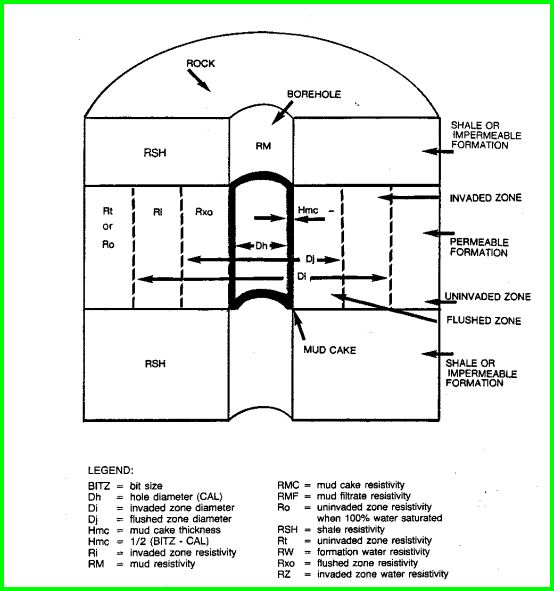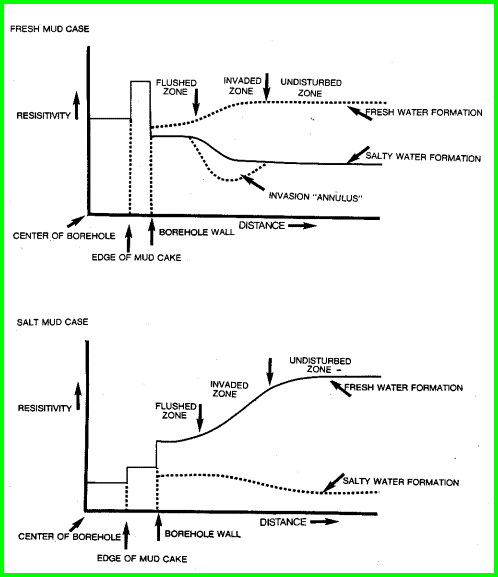 HOW DRILLING FLUID INVASION AFFECTS YOUR LOGS
HOW DRILLING FLUID INVASION AFFECTS YOUR LOGS
Variations in rock properties caused by the invasion of the drilling
fluid into the rock play an important role in petrophysical analysis.
Invasion
is a process whereby drilling mud fluid is forced into the rock
due to differential pressure. The drilling mud is made up of solid
particles and ions dissolved in water. This water displaces the
native formation water to some degree, and mixes with formation
water that is not displaced. The distance to which some displacement
and/or mixing occurs is called the invasion diameter, and the
zone so disturbed is termed the invaded zone. The zone nearest
the borehole, or flushed zone, is the portion of rock where the
maximum amount of displacement and mixing has occurred. The balance
of the invaded zone is sometimes named the transition zone, where the transition
between maximum flushing and no invasion occurs. This is
confusing, as there may be a vertical transition zone between
oil and free water in a reservoir, so we avoid the use of
transition zone in the invasion profile description.
The
invasion process leaves behind the solid particles of the mud,
which collect on the borehole wall. The resulting material is
called mud cake, and may be 3 to 4 inches thick or very thin and
difficult to detect. The mud cake thickness by definition is one
half the difference between the bit size and the borehole diameter.
If the hole is enlarged by erosion beyond the bit size during
drilling, the mud cake thickness may be impossible to determine.
Mud
cake is the sealing agent which slows down invasion. As a result,
high permeability zones which allow quick buildup of mud cake,
invade the least and low permeability zones invade the most or
deepest. Non-permeable zones are not invaded. This sounds
counter-intuitive, but that is what happens with a good quality
drilling mud. Poor quality or native mud may not form a mud
cake, and invasion will proceed in proportion to the
permeability.

Drilling Fluid Invasion Model
The
traditional abbreviations and definitions listed below describe conditions
found within the near-wellbore environment:
Rxo =
resistivity of the flushed zone
Ri = resistivity of the invaded zone
Rt = resistivity of the undisturbed zone
Ro = resistivity of the undisturbed zone which is 100% water saturated
Rz = resistivity of unknown mixture in the transition zone
Rw = resistivity of formation water
Rm = resistivity of mud
Rmf = resistivity of mud filtrate
Rmc = resistivity of mud cake
Rs =
resistivity of surrounding beds
Rsh = resistivity of shale beds
Dh = borehole diameter
Di = invasion diameter
Dj = diameter of the flushed zone
Bitz = drill bit diameter (bit size)
Hmc = mud cake thickness
Computer program will use variations of these abbreviations to
represent the same parameters.
Since
the depth of investigation of logging tools varies, knowledge
of the invasion profile is necessary in making assumptions about
log analysis methods or parameters. This can sometimes be
inferred from the relationship between shallow, medium, and deep
investigation resistivity logs recorded in permeable water
zones.
Most
porosity-indicating logs read the flushed zone and part of the
invaded zone, as do the gamma ray, SP, and shallow resistivity logs.
Micrologs read mostly in the flushed zone. Residual hydrocarbons in
the flushed and invaded zones, especially gas, will influence all
shallow investigation logs.
 RESISTIVITY PROFILES DUE TO INVASION
RESISTIVITY PROFILES DUE TO INVASION
Resistivity distribution in a radial direction from the borehole
determines the response of resistivity logs to various invasion
conditions. Some typical profiles are shown below.

Resistivity Response versus Depth of Investigation
Resistivity
logs that measure different depths into the rock can be used to
estimate the invasion profile. Results are used to judge the reliability
of resistivity data, and to correct the log readings for the effects
of invasion.

